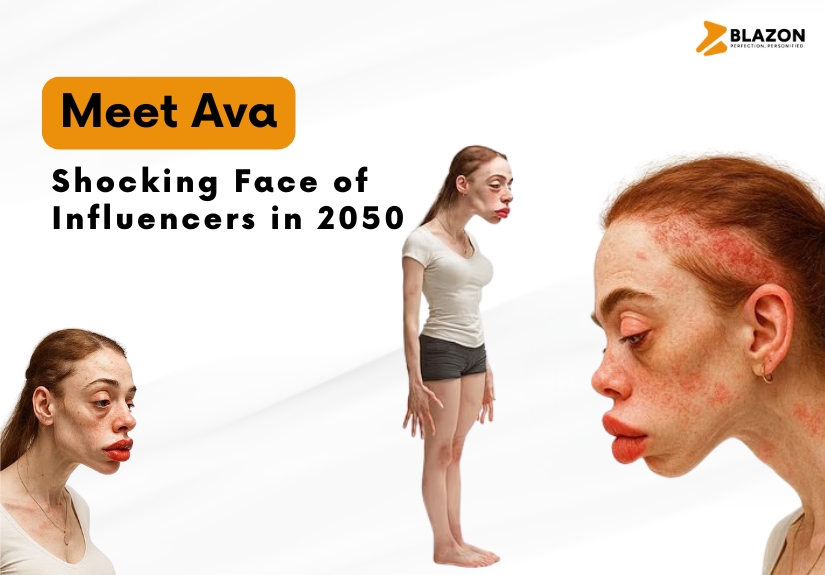The digital world thrives on visuals, perfection, and the constant evolution of influencer culture. But what if the beauty ideals we chase today are shaping a troubling reality for tomorrow? Recently, experts unveiled Ava — a startling model of what the “average influencer” could look like by 2050. Her appearance is not glamorous or flawless. Instead, she carries patchy skin, a hunched back, and a sharply pointed chin, embodying the long-term effects of excessive cosmetic enhancements, overuse of filters, and the relentless demands of online content creation.
Ava is not science fiction. She is based on medical research, expert analysis, and the current trajectory of social media habits. Her look serves as a chilling warning: if today’s influencer lifestyles continue unchecked, this could be the physical and psychological cost of chasing digital perfection.
The Making of Ava
Ava’s design is rooted in scientific predictions of how repetitive digital behaviors and lifestyle choices might impact the human body. Experts considered factors such as:
- Excessive use of fillers and cosmetic enhancements, leading to unnatural facial features and skin damage.
- Postural issues from spending long hours on devices, resulting in a hunched back and strained neck.
- Psychological pressures of constant visibility, where filters and editing apps create distorted self-images.
- High stress and burnout from the 24/7 demand for content, which can manifest in premature aging and skin problems.
The result is Ava — an unsettling representation of what influencers, and perhaps heavy social media users in general, may look like in a few decades.
The Dark Side of Digital Beauty
Today’s influencers often appear flawless, thanks to advanced photo editing tools, cosmetic procedures, and carefully curated content. But behind the polished posts lies a cycle of pressure that pushes creators to continuously enhance their appearance.
The filter culture has already normalized unrealistic beauty standards.
Dermal fillers and cosmetic surgeries are rising among younger generations, influenced by “Instagram face” trends.
Perfectionism and body dysmorphia are increasingly linked to constant online comparisons.
Ava embodies the physical consequences of these behaviors over time. Her patchy skin reflects the toll of excessive cosmetic treatments. Her bent posture highlights the neglected physical health of always being “online.” And her sharp chin symbolizes the exaggerated aesthetics many influencers chase today.
A Cultural Cautionary Tale
Ava’s story is more than a medical model — it’s a cultural warning. If current trends continue, tomorrow’s influencers may pay a high price for today’s clicks and likes. This projection also raises important questions for society:
- How sustainable is the influencer lifestyle?
- Are younger generations being misled by “perfect” online appearances?
- What role should social media platforms play in promoting healthier digital habits?
The message is clear: without balance, the obsession with digital beauty could lead to damaging long-term effects, not only on individuals but on collective cultural standards.
The Path Forward: Rethinking Influence
While Ava paints a bleak picture, her unveiling also opens the door for change. Influencers, brands, and audiences alike can take steps today to avoid this future:
- Promote authenticity: Celebrate unfiltered, natural content to balance unrealistic beauty expectations.
- Encourage healthy habits: Emphasize self-care, posture, mental health, and realistic beauty goals.
- Educate audiences: Spread awareness about the long-term risks of overusing cosmetic treatments and filters.
- Shift industry trends: Brands can partner with influencers who prioritize authenticity and wellness over perfection.
By redefining what it means to “influence,” creators can protect both their health and their audience’s perceptions of beauty.
Conclusion: Ava’s Warning for the Future
Ava may be a model of 2050, but she represents very real choices we are making today. Her hunched back, patchy skin, and sharp chin are not just a futuristic vision — they are a mirror reflecting the potential consequences of our current path.
The unveiling of Ava should be taken not as a prophecy but as a call to action. If influencers and audiences embrace healthier, more authentic digital lifestyles, we can rewrite the future. In 2050, the face of influence does not have to look like Ava. Instead, it could be diverse, vibrant, and — most importantly — human.


